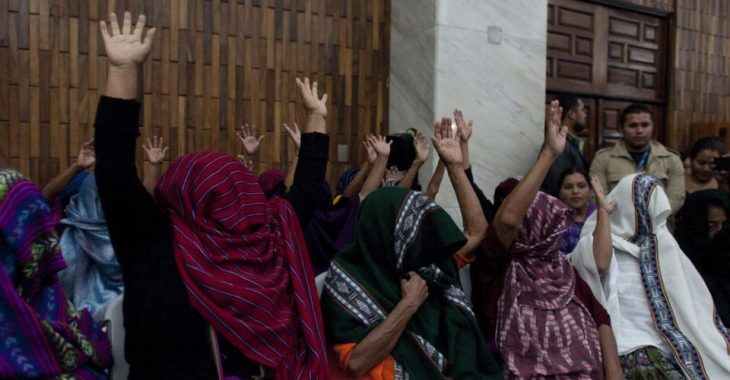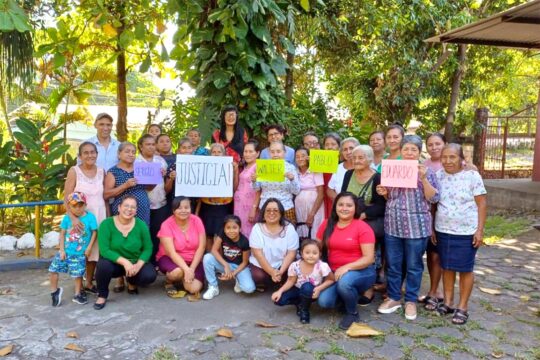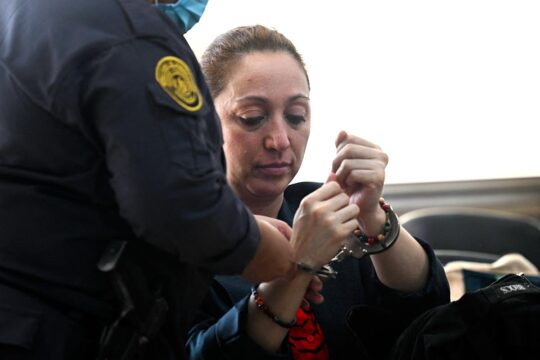The Guatemalan justice system has said it was not a lie. Sexual violence within the Sepur Zarco military outpost was real. More than ten women had to wait 34 years for the State to acknowledge this fact. However, a much deeper story lies behind the sentence; a story of self affirmation, a process by which Guatemala was able to judge a crime that had not been considered as a violation of Human Rights after signing the Peace Accords.
They are not the weakest women in Guatemala. On the contrary. They have had to go through a (personal and collective) process that has taken them over 30 years to understand their own silence and then find a way to break it. Today, they have ensured their voices resound, loud and in Q'eqchi' language, before the Judges in Court A for High-Risk Matters. And their silence, the one they kept for decades, has now become a sentence. There are culprits. There are convictions. The Guatemalan Army made them slaves and sexually abused them in the early eighties in the Sepur Zarco outpost, located between Panzós, Alta Verapaz, and El Estor, Izabal. This is what they said. "What we have suffered is not a lie", this is what they have been saying over and over again, throughout the trial. Sexual violence against 15 Q'eqchi' women was tried and former Lieutenant Steelmer Reyes Girón, the top leader in charge of Sepur Zarco, has been convicted and sentenced to 120 years in prison for crimes against humanity. Along with him, the Chief of military commissioners, Heriberto Valdez Asij, will serve a 240-year sentence, for participating in enforced disappearances of seven small farmers and rape—as a crime against humanity—committed against women who survived Sepur Zarco.
The trial has brought the women, the grandmothers from Sepur Zarco, an opportunity to recount what happened to them, because no one before—neither during the signing of the Peace Accords nor during the preparation of the Reports of the Truth—had inquired about their ordeals. For years, their testimonies have helped to describe what happened to others: tortures, massacres, disappearances. But only a few were interested in what had happened to them: the sexual violence, the slavery. It was scarcely 20 years ago that sexual violence was recognized as a crime in Guatemala.
"Their being was always determined by others. They were asked about the disappeared, the tortured, the massacres, but never about themselves and what had happened to them”, explains Amandine Fulchirone, principal investigator of Weavings of the Soul, a book considered to be the report of the truth about sexual violence in Guatemala, published in 2011. The testimonies of the women of Sepur Zarco were part of this report long before they attempted to file a claim within the justice system. Long before there was a sentence. A task that took ten years to accomplish.
"These women have long gone from being victims to being individuals capable of claiming a right, but only a few realize that, because of the way in which they have gotten to a trial", says Fulchirone.
From the very first day of trial, they arrived at the Courtroom of the Judicial Body wrapped in a shawl. They concealed their faces, their bodies, their hands. And thus they remained static throughout 19 court hearings. Sometimes an eye could be seen; an eye that had lost its shine, with barely perceptible wrinkles. Some other times, it was a gray hair that slipped out.
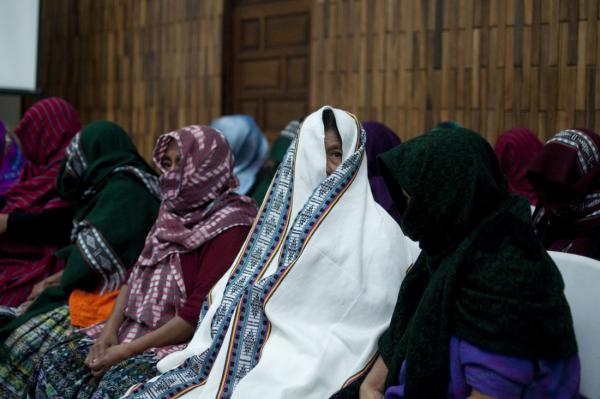
"That's how the justice system works", complains Fulchirone: "Rather than people, it needs victims. The more beaten, the more vulnerable, the weaker you look before the Judges, the better."
Minutes after they heard the Judges at Court A for High-Risk Matters pronounce sentence against Lieutenant Reyes - the same man that forced them to work in Sepur Zarco during six months, the same man that allowed his troop to rape them - the women of Sepur Zarco showed their faces; beneath the shawls, they smiled and waved. "Our heart is Sepur Zarco", responded the public in solidarity to the elderly women who were being compensated by justice.
"They asked for the shawl. It was intended to protect them from the eyes of the accused, which at times could be piercing, full of hatred. The women know it is important to understand it was not their fault. And that once this feeling is passed on to the culprits, they will be the ones to feel ashamed", says psychologist Maudi Patal, from the Community Studies and Psychosocial Action Team (ECAP, for its Spanish initials) that has accompanied the victims.
Minutes after they heard the Judges at Court A for High-Risk Matters pronounce sentence against Lieutenant Reyes - the same man that forced them to work in Sepur Zarco during six months, the same man that allowed his troop to rape them - the women of Sepur Zarco showed their faces; beneath the shawls, they smiled and waved.
However, for Fulchirone, who is now working with women victims of sexual violence in Colombia, the women she saw throughout the Sepur Zarco trial are not the same she met: they are now strong; they do not have to hide to speak or refer to what happened to them. It is they, the strong ones and not those who have concealed their faces inside the courtroom, the women Fulchirone wants everyone to see there in Court. Because "behind the shawls of Sepur Zarco—the shawls with eye-catching colors, the symbol of this case, the hallmark covering women's faces—the history is much deeper and complex, and it describes Guatemala as a set of contradictions.”
Then, there is also a sense—implicit and explicit—of what it means to be a woman in Guatemala, for mestizo women in the city, for indigenous women throughout the country, and especially for those who, in the case of Sepur Zarco, come from the Polochic Valley. "This explains what it means to be a woman before, during, and after the internal armed conflict", says Fulchirone.
In addition, it portrays a breakup with community context. The memories: the guilt. The testimonies: the scare. The rapes: the abuse. But, beneath the covered faces of Sepur Zarco, there is also healing, says Yolanda Aguilar, former Coordinator of the Consorcio de Víctimas de Violencia Sexual Actoras de Cambio ['Agents of Change' Consortium of Sexual Violence Victims.] Aguilar accompanied the women of Sepur Zarco for almost five years, during a process "more political than legal in character" to acknowledge the sexual violence to which they had been submitted.
The political character: to build the capacity of people to claim their rights.
And now, after a sentence has been pronounced, the legal character: which involved filing a complaint and waiting for the justice system to get going. "Maybe as a necessary complement required by some of the women", says Aguilar.
When sexual violence during a war was not a crime
After signing the Peace Accords in Guatemala, the crime of sexual violence was an unpleasant topic to include in the agenda of political agreements between the government and the guerrilla. Rape of women during war was simply ignored, like most of transitional justice issues: there was no agreement as to the cases on which justice should or should not be done. No one considered systematically organizing the cases of violence against women as a priority. Neither was asking within the communities. It was a silence being added to the great silence of the war.
"We have to understand the situation during those years. We were gradually beginning to talk about what had happened. We were breaking the silence about the war, and it was important, but some silences, such as sexual violence, were more uncomfortable than others", says Yolanda Aguilar.
Judge Yassmín Barrios explained this during her verdict: "For many years these women worked hard to break the silence and seek justice."
Read: Yassmín Barrios: “De que crecimos, crecimos” [Yassmín Barrios: Did we grow up? Sure, we did – in Spanish]
The Reports Guatemala: Never Again by the Recovery of Historical Memory Project (REMHI, for its Spanish initials) and Memory of Silence by the Historical Clarification Commission (CEH, for its Spanish initials), set themselves the task of clarifying the truth about human rights violations committed during the armed conflict. "Their contribution (from both REMHI and CEH) was important to rebuild the past, build the present, and think about the future. However, the truth for women was limited", remembers Fulchirone.
For example, 48% of the CEH testimonies are from women who were never seen as victims of human rights violations, but as mere witnesses of what had happened to others.
Neither REMHI nor CEH ever considered analyzing the war and its effects on women. Consequently, 90% of the victims of the armed conflict are men. It was, therefore, the story told by thousands of women to report one incident, the disappearance of their relatives and husbands, but not the violence against them. Aguilar recalls that after she came forward with her testimony—she was sexually abused by the military—eight months before the REMHI was completed, she was invited to assemble a specific chapter on rape and sexual violence, a task she had to undertake without any databases or information to provide details about this side of the conflict, “it was not possible to link rape with massacres or other Human Rights violations.” As a result, none of the two Reports of Truth investigated this crime in full scale. The way women victims of sexual violence lived their day-to-day lives after the war was left in limbo, without any explanation.
One of the most serious issues, says Fulchirone, is that sexual violence "was not considered to be a human rights violation at the same level as tortures, enforced disappearances, executions, and massacres." The argument from the point of view of those years, as Weavings of the Soul tries to explain, is that since the concept of Human Rights was something general to all humankind, something as specific as "feminine" did not fall within this concept. "It was a private matter of women who did not want to talk", says Fulchirone.
Claudia Estrada, one of the investigators for REMHI, recalls that in the interviews for testimonial evidence, sexual violence was not among the questions being asked. "That is why it was not investigated nor recorded with the same detail as other crimes", she says.
However, REMHI gives an account of how "rapes committed by soldiers were massive in the case of massacres or arrests of women." Rape was part of a scene intended to instill terror, prior to massacring Maya women and their communities. REMHI gathered 165 testimonies of sexual violence, but they do not elaborate on the consequences for the State.
Faced with this void, Yolanda Aguilar and Amandine Fulchirone decided to systematically organize sexual violence cases during the war. They would have to formulate the whole analysis and make the recommendations that had been left out of the Reports of Truth. "On the basis of massacres, we began looking for signals of sexual abuses committed during the war. We located several massacres, we found the ladies. The women were grateful because never before had anyone asked them. But it was hard to break that silence", as Aguilar recalls. Chuj women, Mam women, Kakchiquel women, and Q'eqchi' women—the grandmothers from Sepur Zarco—they all stated talking about what had happened to them. They gathered and they talked; they sought for a collective form of self-affirmation. "This was the starting point to find out what had happened in Sepur Zarco", explains Paula Barrios, lawyer of Mujeres Transformando el Mundo [Women Transforming the World.] Feminists from the National Union of Guatemalan Women and Psychologists from ECAP were the primary basis to start investigating and interviewing the victims of sexual violence throughout Guatemala.
Read:
Sepur Zarco: el recreo de los soldados
[Sepur Zarco: Recreation for the Soldiers – in Spanish]
After the criminal complaint was filed with the Justice System in 2011, Sepur Zarco would start telling how a military outpost would operate to provide recreation to soldiers stationed in the areas of Izabal and Alta Verapaz. "For 15 women, a place of sexual and domestic slavery ", remarked Judge Yassmín Barrios during sentence ruling. “They disappeared the husbands, so the women could be raped. Heriberto Valdez Asij is accused of walking soldiers through this task", added Barrios. “The murders —of Dominga Choc and her daughters: Anita and Hermelinda—were the responsibility of Lieutenant Steelmer Reyes Girón.”
Being a woman in the Polochic Valley
Imagine you never knew what love is. Imagine there is no courtship, no dating. That nobody ever told you what menstruation is, or how does a pregnancy occur. Imagine a stranger coming to "ask for your hand in marriage", that he gives money to your parents in exchange for "possessing you." Imagine during your whole life you have only been taught how to be "a wife"—without knowing how to read or write—but there is no one to tell you what that entails. No one ever told you how to have sex—the basics of an intercourse—so, from the day of your marriage you are raped: it hurts. Your only possible role in society is being "someone's wife", the wife of the person who supports you, dresses you, feeds you. Imagine that this social status is your ultimate aim, your lifelong aspiration. Imagine, then, that soldiers arrive, they enslave you, they rape you, and all at once, they take away everything you had believed in.
Imagine, then, that soldiers arrive, they enslave you, they rape you, and all at once, they take away everything you had believed in.
In the Polochic Valley, in the early eighties, this was not something one had to imagine: this is what was really happening. This is what it meant to be a Q'eqchi' woman in the surroundings of Sepur Zarco, just as the book Weavings of the Soul depicts.
Imagine, then, that you survive. And still, the community says it was your fault because you did not die, because you let them, because in spite of the weapons... People points at you "the widow", "the one who likes men", "the whore", "the mistresses of the Army." Imagine that, if you are not "someone's wife", that is, if you cannot fulfill your ultimate "role in society", the only thing that is left for you is "being completely useless." Then you remain silent for decades. They ask you about the massacres, the tortures, the disappeared, but never about what you lost, what you have experienced in your own flesh and blood.
It is only then, that the women of Sepur Zarco acquire meaning. They are the eleven women who made it to trial. The ones that stated before the Judges: "if my husband were here, I would not be in this place." But here again, inside the Courtroom, they receive an ill-treatment: "It could have been that the Q'eqchi' women were engaged in prostitution", as Moisés Galindo, the lawyer defending Steelmer Reyes, argued when referring to the women in this case.
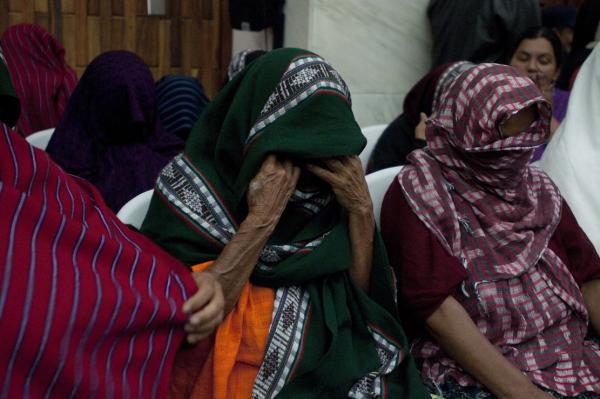
They still have to face the stigma.
During the final verdict, Judge Yassmín Barrios remarked that "women were subjected to degrading treatment, as well as abuses," nonetheless, she respected their courage, their strength.
The guilt, the scare
Amandine Fulchirone explains that when they approached the situation of sexual violence in the Polochic Valley, they discovered that there was talk about slavery, about rapes that took place inside an outpost: "We decided that the first thing we should do, was breaking the silence. We started dealing with guilt and scare: with guilt from the feminist perspective, and with scare, from the perspective of the indigenous cosmovisión [world-view]."
Back in those days (2004-2005), the women of Sepur Zarco said they had been through something "they did not like," and that they dare not name it. Instead of rape, they would say "they grabbed me", "they broke my marriage", "muxuk (desecration)", "they entered with me." Then they started naming everything, and saying vulva, vagina, penis. During the trial, before Court A for High-Risk Matters, the women of Sepur Zarco have been able to call each thing by its name: "They raped me", "they disappeared my husband", "this must never happen again." When they started naming it, they were also able to confront it.
"The hardest thing, their greatest achievement", remembers Aguilar, "was being able to dance." "Building their capacities took some diplomacy. The healing was a holistic process", she adds, as she recalls the exercises and workshops they organized, so the women would learn to express themselves.
On the other hand, in the Q'eqchi' culture, scare takes place when "the spirit leaves the body" due to a great shock. In the Polchic Valley, recovering the spirit is done with the help of an Aj'Quij (spiritual guide). "Often the Aj'Quijs are men, and the women of Sepur Zarco could not explain the origin of their scare, the sexual violence. Years had gone by and they could not recover from the scare", says Aguilar.
During the Sepur Zarco trial, fear, scare, and guilt were part of the evidence of a cultural breakdown, as explained by Anthropologist Irma Alicia Velásquez Nimatuj. "It is not only the individual suffering of the victims, the whole Q'eqchi' culture was damaged", as it was also explained by the Anthropologist and the expert witness in the trial, Rita Segato.
Self-affirmation
Before the eyes of the community, women were left alone, they were widows. Their husbands—Mateo Cac Chuc, José Choc, Antonio Zuc Cac, Juan Cac, Luis Xol, Abelardo Cuc, Sabino Caal—had disappeared. "Our offense was defending our land. That's why they killed our husbands", the women recount in the expert assessment conducted by Velásquez Nimatuj. The claim to their lands, a process brought by their husbands before the National Institute of Agrarian Transformation (INTA, for its Spanish initials), had been left unfinished.
Weavings of the Soul explains: "The accounts of the Q'eqchi' widows bring to light the battles they had to fight so the lands of their husbands would not be taken from them, but be registered under their names." As widows, they started claiming rights within the community and having an opinion. "They started having a voice and taking leadership, although the latter was shaped from the absence of their husbands, it was a new role in society", says Fulchirone.
"This is where the need for social existence and self-affirmation appears", tells Aguilar.
This is the story of the shawls from Sepur Zarco: women who have come a long way to acknowledge themselves as subjects of rights. Before requesting a trial, the women from the Polochic Valley had to face their silence. "The strengthening of their capacities triggered a process of improving self-worth and self-affirmation, which in turn resulted in an improved self-reliance", explains Fulchirone.
"It allowed them to identify and become aware that sexual violence was not a normal and minor thing, but that in fact it constituted a cruel and unfair treatment that compromised their dignity and threatened their lives. This is what they demanded before the accused, in the Court of Justice. Behind the shawls, they were smiling and waving to the crowd. The women of Sepur Zarco were no longer victims, but women with rights. "We, the Judges, firmly believe that crimes of this nature must not be committed ever again", sentenced Yassmín Barrios.
*Translated by Andrea Maldonado San Martín.
Article published by Plaza Publica



